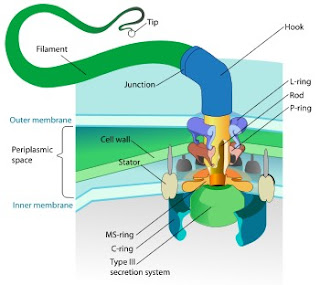BACTERIAL MORPHOLOGY CONTD....
STRUCTURE OF BACTERIAL CELL WALL
A). Structure External To Cell Wall :
1). Flagella : They are hair like appendages that protrudes from cell wall & are responsible for motility. Each of flagella is composed of filament, hook,& basal body.
fig: Ultra structure Of Bacterium Flagella
A). Structure External To Cell Wall :
1). Flagella : They are hair like appendages that protrudes from cell wall & are responsible for motility. Each of flagella is composed of filament, hook,& basal body.
fig: Ultra structure Of Bacterium Flagella
Filaments is attached to hook like structure & composed of flagellin protein . Hook lies at the base
of flagella & filament connects to basal body. Basal body forms a central rod that consists of set of enclosing rings. Gram positive bacteria has only one ring embedded in cell membrane & one in cell wall while gram negative bacteria have a pair of rings embedded in cell membrane & another pair in cell wall.
According to arrangement of flagella, bacteria can be classified as;
a) Monotrichous: Having only one flagella. Eg: Vibrio cholerae, Pseudomonas
b) Lophotrichous: Having a group of two or more flagella at one end of the cell. Eg: Spirillum, Chromatium
c) Amphitrichous: Having a single group of flagella at both ends. Eg: Rhodospirillum rubrum , Camplyobacter spp
d) Peritrichous: Having flagella over whole cell surface. Eg: Klebsiella pneumoniae,
* Alishewanella
* Alterococcus
* Aquamonas
* Aranicola
* Arsenophonus
* Azotivirga
* Blochmannia
* Brenneria
* Buchnera
* Budvicia
* Buttiauxella
* Cedecea
* Citrobacter
* Cronobacter
* Dickeya
* Edwardsiella
* Enterobacter
* Erwinia, e.g. Erwinia amylovora
* Escherichia, e.g. Escherichia coli
* Ewingella
* Grimontella
* Hafnia
* Klebsiella, e.g. Klebsiella pneumoniae
* Kluyvera
* Leclercia
* Leminorella
* Moellerella
* Morganella
* Obesumbacterium
* Pantoea
* Pectobacterium see Erwinia
* Candidatus Phlomobacter
* Photorhabdus, e.g. Photorhabdus luminescens
* Plesiomonas, e.g. Plesiomonas shigelloides
* Pragia
* Proteus, e.g. Proteus vulgaris
* Providencia
* Rahnella
* Raoultella
* Salmonella
* Samsonia
* Serratia, e.g. Serratia marcescens
* Shigella
* Sodalis
* Tatumella
* Trabulsiella
* Wigglesworthia
* Xenorhabdus
* Yersinia, e.g. Yersinia pestis
* Yokenella
* Alterococcus
* Aquamonas
* Aranicola
* Arsenophonus
* Azotivirga
* Blochmannia
* Brenneria
* Buchnera
* Budvicia
* Buttiauxella
* Cedecea
* Citrobacter
* Cronobacter
* Dickeya
* Edwardsiella
* Enterobacter
* Erwinia, e.g. Erwinia amylovora
* Escherichia, e.g. Escherichia coli
* Ewingella
* Grimontella
* Hafnia
* Klebsiella, e.g. Klebsiella pneumoniae
* Kluyvera
* Leclercia
* Leminorella
* Moellerella
* Morganella
* Obesumbacterium
* Pantoea
* Pectobacterium see Erwinia
* Candidatus Phlomobacter
* Photorhabdus, e.g. Photorhabdus luminescens
* Plesiomonas, e.g. Plesiomonas shigelloides
* Pragia
* Proteus, e.g. Proteus vulgaris
* Providencia
* Rahnella
* Raoultella
* Salmonella
* Samsonia
* Serratia, e.g. Serratia marcescens
* Shigella
* Sodalis
* Tatumella
* Trabulsiella
* Wigglesworthia
* Xenorhabdus
* Yersinia, e.g. Yersinia pestis
* Yokenella
e).Atrichous bacteria: Having no flagella. Eg: Diptheriae bacillus Shigella spp.
Some bacteria spirochetes though lack flagella, they show swimming motility in highly viscous media. This motility is due to presence of axial fibril or periplasmic flagella or endoplasmic flagella. Some bacteria show gliding motility when they are in contact with solid surfaces.
Flagella and Motility
Most motile bacteria move by use of flagella (s., flagellum),
threadlike locomotor appendages extending outward from the
plasma membrane and cell wall. They are slender, rigid structures,
about 20 nm across and up to 15 or 20 m long. Flagella are so thin
they cannot be observed directly with a bright-field microscope,
but must be stained with special techniques designed to increase
their thickness . The detailed structure of a flagellum
can only be seen in the electron microscope (figure 3.30).
Bacterial species often differ distinctively in their patterns of
flagella distribution. Monotrichous bacteria (trichous means
hair) have one flagellum; if it is located at an end, it is said to be
a polar flagellum . Amphitrichous bacteria (amphi
means “on both sides”) have a single flagellum at each pole.
In contrast, lophotrichous bacteria (lopho means tuft) have a
cluster of flagella at one or both ends. Flagella are
spread fairly evenly over the whole surface of peritrichous (peri
means “around”) bacteria . Flagellation patterns are
very useful in identifying bacteria.
Advantages Of Flagella;
- movement towards chemical nutrients(chemo taxis).
- it enables bacteria like Vibrio cholerae to move among the tissue & escape phagocytosis by WBC
- they acts as antigen & helps in diagnosis of disease in serological tests.

Comments